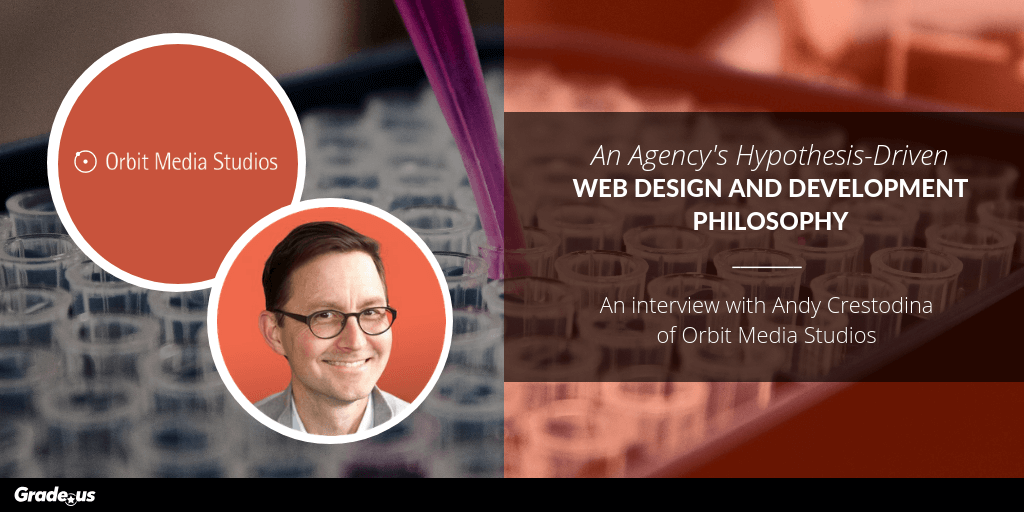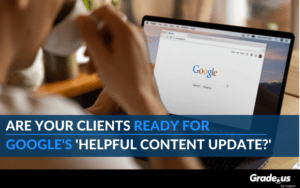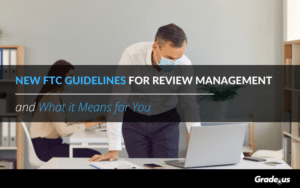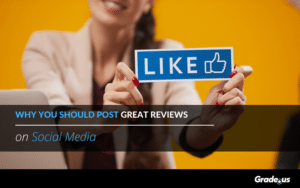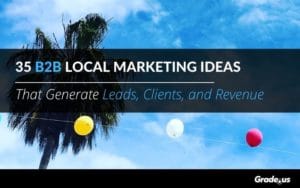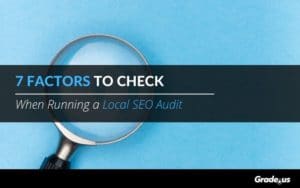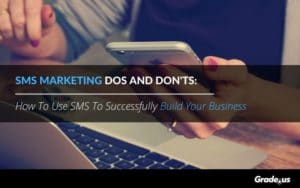If you want to have some real "light-bulb" moments, just spend a few minutes reading any of Andy Crestodina's plethora of articles on Orbit Media Studio's blog. There are hundreds of them, all generated over a career in digital marketing that's spanned nearly two decades.
He absolutely can say, "I was into content marketing before content marketing was cool," and he can get away with it.
He's the author of Content Chemistry, as well as a speaker on the national conference circuit. Go to almost any content marketing conference, and he'll be there.
He's also just an all around nice guy, ready to encourage just about anyone to get bigger and better. After we were done with this interview, he set me to stammering by suggesting I do a few things well out of my comfort zone...and then turned around and made me think I not only could do them, but excel at them.
If that's what two minutes of his mentoring does, I can only imagine what he could do with two days, or two months.
Or even just the twenty minutes or so it will take you to read this interview start-to-finish.
On Starting a Digital Marketing Agency Focused on Content Marketing in the 2000s
Carmen: So you started off with a comic book company. How did you go from that to digital marketing?
Andy: I was excited about the explosion of opportunities that came from interactive content, and in the mid-nineties to late nineties, I started building comic books with my friend. We wrote and drew a couple of comic books in college.
Then the internet comes along and we realize comics can be a choose-your-own-adventure style.
We realized you could add animation, and sound, and all kinds of media. Comic books are inherently multimedia, pictures, and text; a form of media that HTML and flash made a lot more possible.
So we got really excited, and started making comic books. We started a company that was not successful, but it was called Orbit Media Studios. My partner's day job was building websites and doing media, interactive media. My day job was as a recruiter. I wanted to build websites and do things that combined the creative and technical, the heart and the science.
So, I quit my job, started building websites with him (that was in January of 2000). April of 2001, we re-formed the company as Orbit Media Studios, now doing websites. Right away I knew I had to learn SEO, and I had to learn analytics. That started me down the path.
You can't just write a website, you also have to promote it. I started learning search and digital marketing from the early days back then. In 2007, I finally realized that to keep in touch with all of our past clients and potential clients, I needed to have a newsletter. I could just write articles and those could be the landing page from the newsletter.
Content marketing emerged. Content strategy, blogging , SEO, social media, and email marketing all converged into what we now just call content marketing.
I wasn't necessarily an 'innovator', but I was an early adopter of some of those things in 2007. I have been doing it ever sense. Speaking, writing, teaching, doing events, videos; all different aspects of content strategy to promote our business, and also to help others.
On Client Intake and Being Deliberate About Service Offerings
Carmen: So, when you work with clients, what does your intake process look like?
Andy: The majority of our clients are really web design clients. It's the content and the inbound that attracts them. So they fill out the form and become a lead. If they're not a referral, they fill out our contact form and several others. So it's very competitive. It's important for us to generate lots of demand, because there's lots of competition.
It always ends up with just a phone call and a conversation. Most of our clients have had a bad experience, already, working with someone else. Most of our clients are looking for results in the tangible, sort of analytics way, but also a lot of intangible things. They want better partnership, better communication and service. They want beautiful outcomes in web design.
So, beyond that, the next thing they ask for is going to be super-specific to them. There's 10,000 things that people will ask us for. Even earlier today, I could tell you stories. The variety of needs in digital is vast. To be good at this, you need to be able to help people think through options on a massive range of possible challenges and opportunities, which is part of the fun.
Carmen: I read in another one of your interviews that you basically have 100% churn because it's one and done. They get their website and you're done with them.
What made you guys decide to do that instead of also offering the ongoing, SEO maintenance service?
Andy: We do now offer an ongoing SEO service. It's optimization. It's not just SEO, it's also conversion optimization, but we only do it for select clients.
This is a mature company. We've been around for 18 years. We have a CEO and 36 employees and hundreds of clients. So we don't take the idea of launching a new service lightly. We're very deliberate about it. We know that it's a big opportunity for both us and our clients, but to do it well, you need to be staffed for it. You need a process for it. You need to have a consistent approach that's successful for both you and the client.
In the early days of the business--every business evolves from being more entrepreneurial to more managerial. In the early days, you'll just take whatever. I remember we used to do whatever anyone needed.
But as a business becomes more process-driven and consistent in its results and success, inherently it becomes less adaptive, and more disciplined about not chasing everything that comes along.
It's partly a matter of business maturity, and partly track record. Partly, it's the demand we generate. But it's something we are doing now, because it's a great opportunity and our clients really need it.
On the Fundamental Requirements of Web Design (No Matter the Business Size or Type)
Carmen: Awesome.
It seems like you customize everything for the client. What does that look like, the process for a small business versus a big business, like yours, with a CEO and lots of employees?
How do you tailor-make your strategy or approach for these companies and work with them? Maybe tell me some of those stories from earlier, because I'm interested!
Andy: Well, the outcome should be consistent. Every website needs to do several things well, or it fails.
It needs to attract visitors, usually from search. It needs to convert visitors through visitor psychology, clarity of messaging, and usability. It needs to be easy to update. It needs to be beautiful and on brand.
So, every single business, from the tiniest Mom & Pop to the biggest enterprise, has some fundamental requirements for web design. There are few exceptions to that. For a marketing website, these are things they all have in common.
To deliver on that, every process needs to begin with some customer and audience intimacy. The process always begins with interviewing the client, researching their audience, and understanding what the top considerations are.
Pick any company at all. Last website I visited was a banking website. I'm looking at it right now. Every visitor to this website has a specific need. There's something that happened in their life that brought them here. 90% of them are current customers. They're just going to log in.
But this is the marketing side.
They want to move banks. They want to change banks. They want to open a new account. What happened in this visitor's life?
For me, I've got little kids. I need to start some kind of college savings. So, you start on Google. You search for a phrase. The page ranks or it doesn't. If it does, you click and you land on the page. The page speaks to your needs or it doesn't. If it does, you flow through the content and see the messaging.
Then the page supports its messaging with evidence or it doesn't. If it does, you see how there's like a chain here, with links?
Carmen: Yeah!
Andy: The links are strong, or weak. If it supports its message with evidence, they're more likely to believe it.
Then it has a call-to-action, or it doesn't. If it does have a call to action and it's compelling and specific, I'm likely to click.
The website was either beautiful or not. It was easy to use or it wasn't. It answered my questions or it didn't. It felt human and personal or it didn't. It ranked high, or it didn't.
That is a simple use case in a banking website for someone with college savings needs.
But you can do that for any website. With that common set of requirements, good web design needs a process that starts with key phrase research, audience research, understanding the brand and collecting the brand assets, evaluating what's working, deciding what should be redesigned or not, and what should be rewritten.
You go through that process of creating both the container (which is the design) and the content (the words and pictures). Every web design company has a similar process, ultimately.
But the question is how much experience do they have? How skilled are the team members? How good are they at forming hypotheses and creating a unified container and content? And ultimately, how good is the final product at attracting visitors and converting them into leads?
Fascinating, right? Super fun, but definitely process-driven. Websites have more in common than you might think.
On How To Disagree With Clients and Educate Them
Carmen: Now, do you ever have a situation where even though you've done all this initial interviewing, and you've taken the time to get to know their needs, and you make some proposals or suggestions, and they push back?
How far do you take that when sometimes people don't know what they really need, and say no to things they really need? How far do you push that, trying to help them out?
Andy: It's a great question, Carmen. Basically you fight, but you don't die. It's okay to lose.
So let's say this: You're a client. We're building a banking website, and you're the bank. We're making a page about college savings.
Your idea about this page is that the top of it should have a message about, "We're #1 bank, we're the best, and there's no banks better than us."
My feedback to you is, "That's very common. It's expected. It's not likely to be effective, because you're not answering a visitor's questions. You're not supporting it with evidence. That is a weak main message to put at the top of this page."
You, the bank, says, "No, that's what I want."
My response is, then, "Okay, let's go with your idea!"
Because the final page, once designed, is going to be better than the current page in six other ways. So even if a client pushes us to do something we don't recommend, we can still get great results for that client. Because sometimes their idea is a good idea. We'll find out in the analytics. It's all hypothesis anyway.
But it's not the only thing. It's not worth delaying the project. It's not worth ruining trust or hurting a relationship. It's not my website anyway, it's your website. I have to honor you and listen to you, or you won't listen to me at all. It doesn't make sense to argue over something needlessly for delaying a project for two weeks, when in fact that one element was just one part of one page.
For expediency, it's far better to proceed, and win more battles than you lose. Fight each battle, but don't fight too hard. And then go live.
The best day to launch a new website is the first day it's better than the old one. One of the main reasons why website projects get a low ROI is because they get delayed for months. People are agonizing over some small element. When, in fact, the other 90% is already better than the old site. You get higher ROI if you launch sooner.
Digital ink is never dry. You can go change that page later.
After it's live, you're less likely to be totally wrapped up on that header on that one page.
I can suggest to you, two weeks later, "Hey, mind if we try something else? Let's run a test. I want to see if this works."
Your temperature and emotion around that page has probably gone down. People get very emotional prior to a website launch. After the website launches, they're often pretty laid back.
So, don't fall on your sword, is my recommendation!
Carmen: Now, you've sometimes been known to say, "if I built cars, I'd teach driver's ed." How does that apply to what you do?
Andy: It's the idea of ongoing digital marketing, which is when you create content, you send an email, you interact with social media, you're measuring results and analytics. You're putting out webinars and doing interviews and everything you do.
That is the ongoing, never ending cycle of a marketer.
So, that's like driving the car. Building the car.
You build a website every three years, or every five years. There's a revolutionary change when you redesign a website.
There's an evolutionary change that happens all the time.
What we do is rehab. What the clients need to do afterwards is fitness. It's something like that.
But that's the idea. We teach people to get better results from their marketing. We do so with a book, we wrote a book, we write articles, we run events. Our clients attend these, and they get better results because they know how to better use and leverage their websites.
On The Most Challenging Types of Businesses and Projects
Carmen: What kind of client, business, or industry presents the biggest challenge for you from a strategic perspective?
Andy: You're asking fun questions!
I'd say media websites, like an online magazine. I think those are very strange websites, because their goal is not conversion. They're not really trying to turn people into leads or customers. They're trying to turn visitors into subscribers. They're trying to grow lots and lots of traffic. They monetize that audience, often, by selling ads to other businesses.
Every one of those companies is like an arbitrage company. How inexpensively can I win visitors from digital monopolies like Facebook and Google? How can I sell this visitor's attention to other companies? They're weird, because success and failure are partly the same. They want to keep their visitors, but they're also trying to sell their visitors.
They're always trying to reduce bounce rates and drive value to their advertisers. Those goals are totally in conflict. It's strange. I feel perfectly at home and excited to build digital marketing platforms for lead generation businesses and for eCommerce companies, where you attract visitors and you get them to take an action, or they change their status from a visitor to a lead or from a visitor to a customer. It's about trust and usability.
If you're just an online magazine, I think those are very challenging businesses these days, because organic click through rates in Google keeps going down, organic Facebook reach keeps going down. Those are tough companies to run.
Carmen: I imagine it's a fine line even on limiting your sales. There are some big name magazines I don't even go to, or I go to the cache, because I know they're going to play four or five videos and lock up my system. And I'm like, "You're taking it too far, guys."
Andy: Yep. They're hurting trust with their readers and viewers with overselling. There's a newspaper here in Chicago, and I don't go to their website. There's so much javascript on each page. It feels like your computer starts to heat up as soon as you load it. Just physically getting hotter. "Wow, what's going on right now on my browser. It's crazy!"
Carmen: Is there a company type that's more challenging from a technical standpoint?
Andy: Yeah, eCommerce is always the most challenging. Every website integrates with other stuff. So every lead generation site integrates with a customer relationship management system. It integrates with analytics. It integrates with other tracking tools and advertising tools.
An eCommerce site has so many different integrations these days.
Every eCommerce site integrates with a different gateway, of course. There's a security certificate, but they also integrate with review systems, inventory systems, accounting systems, fulfillment centers. There's so much that happens on the back end with an eCommerce website that you can't see.
It makes those projects really, really interesting. They're fun. You can measure results in dollars. eCommerce is a blast. But in terms of technology and functional requirements, they're at the very high end of the spectrum, because there's so many different things they connect with.
On Reporting and Analytics For Web Design and Optimization Projects
Carmen: For the clients that you do provide analytics and optimization, how do you report on your performance for them?
Andy: Well, like I said, every idea for every website, every conversation in every conference room, it's all really just a hypothesis.
So, the best way to work with a client is to honor every idea. They've got an idea. You've got an idea. You put everyone's brainstorms and ideas onto a spreadsheet.
You can then score each hypothesis. This one effects a great percentage of visitors, this one effects very few. This one's expensive to do, this one's free. For this one, we have strong evidence for this, for this we have weak evidence.
Now you have a spreadsheets with cells and formulas and hypotheses. You're deciding, "Ah, yeah, let's do these top three here next."
For each website change--this is digital, so it's not like branding, or outdoor ads, or direct mail--we should never make a change to a website without knowing in advance which of the metrics and analytics it will effect.
Report on the specific metric.
Carmen: So you're talking, on one page you're trying to improve the bounce rate, another conversion?
Andy: Yeah. It depends on the page.
Let's take the home page.
The navigation page throughout the website has a big label that says: "Solutions."
Hypothesis: If we change that to say, "IT managed services," which is what the company does, we'll get a higher click-through rate and more traffic to that deeper interior page from other pages.
Ok, let's try it. Cost is zero, impact to percentage of visitors is high, because it's navigation, it's global. So, it would score high in the hypothesis prioritization spreadsheet.
If you were to proceed with that, how would you know it's successful?
You would simply look at the navigation summary for that IT Managed Services page, and see if it's getting more traffic from other pages. Measure its performance and click through rate from any other page, excluding traffic that's a landing page from Google, maybe.
So, that's an example of where hypothesis, prioritization, website change, and metric are reported. Maybe like 1 in 3 of your ideas are successful.
But if you know visits to that page correlate with conversion, that would be a great hypothesis and something to test.
Now that wasn't an actual test. I just described that as "make the change and measure the impact". The state-of-the-art way to do that is via Google Optimize. You can create an alternate version of that navigation label on the home page for example, and tell Google Optimize that 'clicks on that link' are the success metric. Then let Google Optimize tell you if it's successful or not.
Carmen: I've never heard anybody speak quite like this about the process.
How did you come to the idea of using the scientific method for website creation and optimization?
Andy: Well, after going to dozens or hundreds of conferences and sessions, after meeting with and talking to a thousand companies, after being in rooms where ideas were pitched from all different kinds of vendors and partners, you end up realizing that the people who are best at this are the ones who don't trust themselves.
They're using the scientific method. Everything is a test, and everything has a measurable impact.
In the pay-per-click world and the conversion optimization world, this is really the only way those people work. There isn't anything that's squishy at all. The opposite end of the spectrum is people who do things like branding. In branding there may be research, but they're never really going to give you hard data about whether red or orange is a better logo.
They might have thought about it and spent $20,000 considering these options, but the ROI for that specific spend isn't quite as concrete.
It is, basically, the difference between digital marketing and all the old-school advertising stuff. The smartest people are all taking these analytical approaches.
Opinion versus opinion? The highest paying person wins. They're a hippo.
In opinion versus data, the data wins. So if you want to have a great meeting with a client, bring some data.
Or if you want to get your idea considered, suggest it as a test. Talk about the direct impact.
If I go to a meeting and I explain how everything that is done is a link in a chain towards money, and based on your analytics, here are the weaker links, you're very likely to trust me to set strategy for your digital. I'm very likely to actually drive revenue and results, because it wasn't just, "Here's what I think, here's what you think, okay, let's compromise and never see if it worked." Everything is really just hypothesis formation that leads to an impact.
Everyone knows the truth, and you rinse and repeat.
On Maintaining Client Relationships
Carmen: Very cool! What's the most important part of maintaining a relationship with your clients after their website launches?
Andy: These are good! That's tough! That's actually tough, because there are lots of clients who are just not that active on their websites. You couldn't get them to call you back if you tried.
There are other clients that never stop looking at their website and keep wanting to tweak things even though there are likely other parts of their business or other parts of their marketing that would be more effective than wordsmithing a paragraph at the bottom of their page just over and over.
So some people are just super active, and some people are not active at all. You need to be responsive and persistent with both.
You know there is value if they were to take an action. Stay on it. Keep nudging. Do it in a way that builds trust and you're not annoying. Those that need a lot of help and want to keep doing more and more with their site? Don't exhaust them with lots of little quotes. Suggest an optimization agreement, or a service agreement, so you have a certain amount of hours per month, and you can stay active with them without always having to go back and talk about money.
But be realistic and be honest. Don't keep spending money on a site if it's time to redesign it. Nobody replaces the transmission on a 30-year old car. It's time to get a new car.
There's also a point of diminishing returns when you should stop enhancing a website, save that money for the redesign, plan ahead six months to a year, and make a bigger change.
On the Life Cycle of a Website and the Redesign
Carmen: Why do websites need to be completely relaunched or redone every 3-5 years?
Andy: It's a fair question.
Visitor expectations aren't static. What we think is a good website is slowly changing every day. If you don't redesign your website, you end up with a competitive disadvantage, because your website looks worse than everyone else's website.
Every website must be redesigned eventually. If you look at websites from ten years ago, and there's plenty that are still around, they look small. They look crowded. They have lots of columns. They aren't mobile responsive.
Technology changes. Visitor expectations change.
Modern websites have more whitespace. They often have one column layout. They have embedded video. There's usually simple, clear text. The fonts are slightly larger. They look good on mobile. The navigation tends to be either quite simple or with big mega drop downs. Those little tiny drop downs are out of style. Carousels are out of style. They just don't perform well in usability tests, or in analytics. You can see it.
The Internet is always evolving. And if a website stays still, the performance of it slowly erodes.
On Following Google SERP Layouts Versus Rankings and Explaining Trends To Clients
Carmen: Switching gears a little bit, you've blogged a lot about the changing state of Google and search engine results. There's another core update happening.
How do you research and monitor the core algorithm updates?
Andy: This is counterintuitive. But I really don't pay a lot of attention to changes in Google. The big change in Google, in my perception, isn't so much in the search ranking algorithm and rankings changing.
It's in Google putting so many features in the search results pages. Search for something now, and you will find ads at the top, followed by a map, some images, interesting finds. There are little pictures, snippets, star reviews, news items, featured snippets at the box, question and answer boxes. There's knowledge cards on the side. If you're on desktop you'll see a big knowledge panel.
So, the amount of visible noise in a search results page is now so high compared to what it used to be that click through rankings versus organic rankings is going down, a lot. It's something like half of all search results, half of all searches lead to no clicks at all. Visitors get enough information from the search results page.
They don't click.
That's a huge trend, and it's happening slowly, every day.
But the articles I've written and the pages I have that rank, right now? A lot of them ranked last year, the year before, and if you make a great page on a topic, as long as it's a topic where there's not tons of new content coming out every day, like news topics, rankings change a lot, because there's lots of new content coming out on that topic.
But if you write a great article about content strategy, or email click-through rates, and you rank well through good SEO, through relevance and authority, your rankings are quite durable in my experience.
Lots of stuff, if it ranks now, it's probably going to rank a week from now, a month from now, sometimes even a year or more.
Carmen: So that focus on evergreen content is how companies can compete when the main website they're trying to go up against is Google?
Andy: That's a good way to put it. The content is evergreen. If it's not, then you don't really have an SEO strategy. If your content is timely, ephemeral, and date stamped, you'll probably do better on social or something else.
But Google isn't helping us with these changes. Google and Facebook are experts at keeping their visitors. We are all sort of at the mercy of these digital monopolies. So, the saving grace for a marketer is to have helpful, useful evergreen content that either ranks or gets shared a lot.
Visitors come from social or search, but then once they land, they found it so great that they subscribed.
Email is our safety, because you own your email list. It's not proprietary, right? Email, search, and social are the main channels for content marketing. Email's the only one you really control.
It's very competitive, but at least there's not a company between you and your audience with email.
Carmen: Makes a lot of sense to me.
Now, how do you explain these changes to clients?
I imagine they're not keeping up with the trends as well as marketers do.
How do you help them understand what needs to be done now versus what their perception might be? There are still people who think if you're a bankruptcy attorney you need to say that 17 times on the first paragraph.
How do you help them understand that's not the case anymore?
Or some of these other changes. That they don't need a carousel? Or where they're kind of in a fear state. Afraid if they change it, they'll lose business.
How do you handle that?
Andy: Well, data is going to be more effective than persuading people than making an unsupported statement.
Carousels. Here are four or five different studies that show carousels don't perform as well as if that content was stacked up.
Take your subsequent slides, put them in a stack, and you're going to get more visibility on those slides. Most people aren't going to see the subsequent slides in a carousel.
There's the data, where you can run a test for them and show them on their site.
Another way is just to make sure that you're doing things patiently. If someone says, "I need you to do keyword stuffing, that's how they do it in my industry," you can say, "okay, let's think about that, let's talk about that." I used to do that, there was a time when that made sense. Here's the modern trend, here's the research.
Here are the other high ranking pages. Let's count the keyword frequency on those pages.
Oh, look, some of them have a lot, some of them don't. Maybe there's other search engine factors that are more heavily weighted.
Let's look at the authority of these high ranking pages.
Oh, look, the ones that rank high actually have tons of links to them. Maybe that's a bigger factor. It's just thinking through.
Also it's not necessarily practical advice for me to say this, but if you as a marketer have published lots of stuff in the past, then people who contact you may already have been exposed to lots of your content, and they may be ready to listen.
It helps a lot to put useful stuff out there. If someone contacts you and says, "Hey, I've been reading you for awhile," well, now you know it's going to be a more useful conversation.
On What Gets You Out Of Bed in the Morning
Carmen: Finally, what do you love most about what you do? What gets you going in the morning?
Andy: I'm a service-oriented guy. I grew up working in restaurants. I like helping people. I like to see the light-bulb moments when you explain something to people. Like, working with a bank, 95% of visitors click on the login button when they go to the site.
They look at analytics and they're all confused. "There's a lot of noise in here."
No problem. Let's make a segment to remove those visitors. It's a conditional segment. I only want to see those people who did not log in. I'm calling it, "Non customers." Great, condition, exclude, click equals, save.
"Ah!" The client gets so excited and happy in that moment. They just realized they can, with a few clicks, in less than one minute, a lot of the information they're looking for is right around the corner. I'm going to show it to you. We're going to turn around this corner, and you're going to get what you want.
They get happy! They improve over time. You can see how they make better decisions, or they refer back to that segment, or they talk to you. If you love people, if you love teaching, if you love creative processes and data, both? This is the perfect business. That's super fun!
Stay on top of Andy's other insights by following him on Twitter at @crestodina.
About the Author
Raney C. Hudson
Raney C. Hudson is an independent content consultant with a 10+ year track record in the digital marketing industry.

